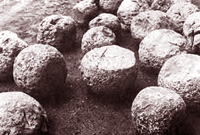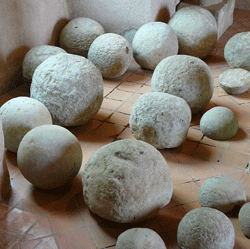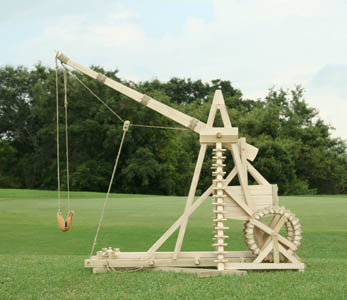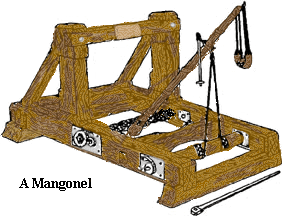The Word Perrier denotes a stone throwing device and is used as a general term to cover a number of different types of war engine. Perriers were employed either to smash masonry walls or to throw projectiles over them. All trebuchets were made from wood. With the introduction of gunpowder, the perrier ceded its place as the siege engine of choice to the cannon. Specific types are:
- Traction Trebuchets
- Counterwieght trebuchets
- Onagers and Mangonels
- Balistas
Traction Trebuchets
|
The trebuchet derives from the ancient sling. A variation of the sling contained a short piece of wood to extend the arm and provide greater leverage. This was evolved into the traction trebuchet by the Chinese, in which a number of people pull on ropes attached to the short arm of a lever that has a sling on the long arm. This type of trebuchet is smaller and has a shorter range but is a more portable machine and has a faster rate of fire than a larger counterweight powered one. The smallest traction trebuchets could be powered by the weight and pulling strength of one person using a single rope; but most were designed and sized to utilize from 15 to 45 men, generally two per rope. These teams would sometimes be local citizens assisting in the siege or in the defense of their town. Traction trebuchets had a range of from 2000 to well over 3000 feet when casting weights up to 750 pounds (60 kg). A traction trebuchet functions in the same way as a counterweight trebuchet, except that instead of a hoisted weight, the hurling arm is powered by a crew of men, pulling on ropes attached to the short lever arm. A counterweight trebuchet is powered by a very heavy counterweight, acting on a lever arm. The fulcrum of the lever (usually an axle) is supported by a high frame, and the counterweight is suspended from the short arm of the lever. The sling is attached to the end of the long arm of the lever. |
|
One end of the sling is captive, while the other end is
hooked to the long arm in such a way as to release when
the arm and sling reach the optimal hurling angles. The
trebuchet is energized by lowering the long arm and raising
the weighted short arm, usually with a winch, and is locked
into the charged state by a trigger mechanism (cocked).
With the long arm lowered near ground level, the sling is
loaded with the projectile, and laid out on the ground,
with the captive and hooked ends away from the target, and
the load and pouch laid on the ground toward the target,
under the trebuchet. When the trigger is released, the weighted
short arm is driven by gravity into an accelerating pendulum
motion, causing the lighter, long arm of the lever to revolve
around the fulcrum at the opposite arc, which in turn, pulls
the sling and its contents into a whipping motion at the
end of the long arm. As the arm continues to swing past
the vertical position, the counterweight rises, causing
the lever motion to begin to slow down, while the sling
continues to whip forward around the end of the long arm.
When the sling reaches its launch angle, one end slips from
its hook, releasing the projectile toward the target.
It is believed that the first traction trebuchets were used in China as early as in the 5th century BC, descriptions of which can be found in the 5th century BC. The traction trebuchet next appears in Byzantium. The Strategikon of Emperor Maurice, composed in 539, calls for "ballistae revolving in both directions," , probably traction trebuchets. The Miracles of St. Demetrius, composed by John I, archbishop of Thessalonike, describe traction trebuchets in the Avaro-Slav artillery: "Hanging from the back sides of these pieces of timber were slings and from the front strong ropes, by which, pulling down and releasing the sling, they propel the stones up high and with a loud noise."
Counterwieght Trebuchets

![]()

![]() The
counterweight trebuchet appeared in Christian and Muslim
lands around the Mediterranean
Sea in the twelfth century. It could fling three hundred
pound (140 kg) projectiles at high speeds, at times including
corpses infected with various diseases including the black
plague, in an attempt to infect the people under siege,
as a medieval variant of biological warfare. Trebuchets
were far more accurate than other forms of medieval catapults.
The
counterweight trebuchet appeared in Christian and Muslim
lands around the Mediterranean
Sea in the twelfth century. It could fling three hundred
pound (140 kg) projectiles at high speeds, at times including
corpses infected with various diseases including the black
plague, in an attempt to infect the people under siege,
as a medieval variant of biological warfare. Trebuchets
were far more accurate than other forms of medieval catapults.
Our first clear written record of a counterweight trebuchet comes from an Islamic scholar, Mardi al-Tarsusi, who wrote in 1187, "Trebuchets are machines invented by unbelieving devils." (Al-Tarsusi, Bodleian MS 264).
|
|
|

![]() The
largest trebuchets needed exceptional quantities of timber:
at the siege of Damietta, in 1249, Louis IX of France was
able to build a stockade for the whole Crusade camp with
the wood from 24 captured Egyptian trebuchets.
The
largest trebuchets needed exceptional quantities of timber:
at the siege of Damietta, in 1249, Louis IX of France was
able to build a stockade for the whole Crusade camp with
the wood from 24 captured Egyptian trebuchets.

![]() The
lever must be as light as possible for maximum acceleration,
yet strong enough not to break under the stress. The ratio
of the length of the long to the short arms of the lever,
and to the sling length, are important factors in determining
the range of the projectile. The object of a good design
is to transfer as much energy as possible from the falling
counterweight into the projectile. The maximum range for
a hypothetical 100% energy transfer, R, of the projectile
can be shown to be R = 2hM /m, where h is the distance the
counterweight falls, and M and m are the mass of the counterweight
and projectile, respectively. The efficiency of a real trebuchet
is the ratio of the actual range achieved to the calculated
maximum range.
The
lever must be as light as possible for maximum acceleration,
yet strong enough not to break under the stress. The ratio
of the length of the long to the short arms of the lever,
and to the sling length, are important factors in determining
the range of the projectile. The object of a good design
is to transfer as much energy as possible from the falling
counterweight into the projectile. The maximum range for
a hypothetical 100% energy transfer, R, of the projectile
can be shown to be R = 2hM /m, where h is the distance the
counterweight falls, and M and m are the mass of the counterweight
and projectile, respectively. The efficiency of a real trebuchet
is the ratio of the actual range achieved to the calculated
maximum range.

![]() There
are no really detailed descriptions of medieval or earlier
trebuchets that give the dimensions or shape of the beam,
the ratio of its long arm to its short arm, and so on. No
specimens or models from medieval times survive. The few
extant contemporary drawings of them are highly schematic
and sometimes show physically impossible proportions. Methods
used for optimizing their performance and design were apparently
closely held military secrets.
There
are no really detailed descriptions of medieval or earlier
trebuchets that give the dimensions or shape of the beam,
the ratio of its long arm to its short arm, and so on. No
specimens or models from medieval times survive. The few
extant contemporary drawings of them are highly schematic
and sometimes show physically impossible proportions. Methods
used for optimizing their performance and design were apparently
closely held military secrets.
Placing and aiming the trebuchet was also, no doubt, done by empirical trials. Small adjustments could be made by changing the angle of the hook holding the free end of the sling, a process which requires a heated forge on a full-scale engine. For larger, quicker adjustments, the length of the sling can be altered. Small adjustments from side-to-side can also be made by moving the channel in which the missile and sling slide in the base of the frame. The trebuchet itself could be moved as well, but with larger trebuchets, this would have been difficult; the largest trebuchets could weigh many tons.

![]()

![]() Because
of the time required to load the sling and to raise the
counterweight, a large trebuchet's rate of fire was slow,
perhaps not more than a couple of shots an hour. This was
due both to their size and the mass of their counterweights.
Smaller trebuchets can fire a couple of times a minute.
The payload of a trebuchet was usually a large rounded stone,
although other projectiles were occasionally used including
dead animals, beehives, the severed heads of captured enemies,
small stones burned into clay balls which would explode
on impact like grapeshot, barrels of burning tar or oil,
Greek fire, pots of burning lime, unsuccessful ambassodors,
prisoners of war, hostages, and captured spies.
Because
of the time required to load the sling and to raise the
counterweight, a large trebuchet's rate of fire was slow,
perhaps not more than a couple of shots an hour. This was
due both to their size and the mass of their counterweights.
Smaller trebuchets can fire a couple of times a minute.
The payload of a trebuchet was usually a large rounded stone,
although other projectiles were occasionally used including
dead animals, beehives, the severed heads of captured enemies,
small stones burned into clay balls which would explode
on impact like grapeshot, barrels of burning tar or oil,
Greek fire, pots of burning lime, unsuccessful ambassodors,
prisoners of war, hostages, and captured spies.
Trebuchets were powerful weapons, with a range of up to about 300 yards/ 270 m. Castle designers often built their fortifications with trebuchets in mind; The range of many trebuchets was in fact shorter than that of a longbow in skilled hands, making it dangerous to be a trebuchet operator during a siege.
 |
 |
A trebuchet can increase its efficiency by allowing the counterweight to take the straightest possible downward path. This maximizes the transfer of the counterweight's potential energy to the projectile rather than to stressing the frame. Mounting the counterweight on a pivot (below top) straightens the path of its fall, increasing its effectiveness. A fixed counterweight trebuchet in particular can therefore be made more efficient by the addition of wheels to allow the frame to move freely back and forth (below bottom). This also allowed the trebuchet to fire farther.
The addition of wheels also makes the trebuchet more stable as part of the forward momentum of the falling counterweight is transferred to the forward motion of the trebuchet instead of a tilting action of the vertical frame, possibly tipping over of the machine or severely damaging the structure. The velocity of the trebuchet frame is added to that of the item being thrown, increasing its velocity and range by up to 33 percent. The wheeled trebuchet can effectively employ a fixed counterweight, mounted to the short end of the throwing arm, rather than the pendulum weight described above. The weights were usually stones and rubble, since lead was far too expensive and could be used for better purposes in a siege. |
|
.
Onagers and Mangonels

![]() The
onager was a post-classical Roman siege engine. Its name
comes from that of an onager (a wild jack ass), the similarity
being its violent kicking action. The onager was a type
of catapult that used torsional pressure, from twisted rope,
to store energy for the shot. It consisted of a frame placed
on the ground to whose front end a vertical frame of solid
timber was rigidly fixed. Through the vertical frame ran
an axle, which had a single stout spoke, on the extremity
of which was a sling used to launch a projectile.
The
onager was a post-classical Roman siege engine. Its name
comes from that of an onager (a wild jack ass), the similarity
being its violent kicking action. The onager was a type
of catapult that used torsional pressure, from twisted rope,
to store energy for the shot. It consisted of a frame placed
on the ground to whose front end a vertical frame of solid
timber was rigidly fixed. Through the vertical frame ran
an axle, which had a single stout spoke, on the extremity
of which was a sling used to launch a projectile.
 In
action the spoke was forced down, against the tension of
twisted ropes or other springs, by a windlass. It was then
suddenly released. The spoke kicked the crosspiece of the
vertical frame, and the projectile at its extreme end was
shot forward. Onagers of the Roman Empire were mainly used
for sieging forts or settlements. They would often be armed
with huge stones or rocks that could be covered with a flammable
substance and set alight.The Romans greatly improved the
onager's maneuverability by adding wheels to its base. The
wheels and the onager's light weight made it easy to move.
In
action the spoke was forced down, against the tension of
twisted ropes or other springs, by a windlass. It was then
suddenly released. The spoke kicked the crosspiece of the
vertical frame, and the projectile at its extreme end was
shot forward. Onagers of the Roman Empire were mainly used
for sieging forts or settlements. They would often be armed
with huge stones or rocks that could be covered with a flammable
substance and set alight.The Romans greatly improved the
onager's maneuverability by adding wheels to its base. The
wheels and the onager's light weight made it easy to move.
In the Middle Ages (recorded from around 1200) a less powerful
version of the onager was used that held the projectile
in a fixed bowl instead of a sling. This was so that many
small projectiles could be thrown rather than one large
one. This engine was sometimes called the mangonel, although
the same name may have been used for a variety of siege
engines.

![]() A
mangonel was a type of catapult or siege machine used in
the medieval period to throw projectiles at a castle's walls.
The mangonel did not have the accuracy or range of a trebuchet
and threw projectiles on a lower trajectory than the trebuchet.
A
mangonel was a type of catapult or siege machine used in
the medieval period to throw projectiles at a castle's walls.
The mangonel did not have the accuracy or range of a trebuchet
and threw projectiles on a lower trajectory than the trebuchet.
The mangonel was a single-arm torsion catapult that held the projectile in a sling. A similar and perhaps older device was nicknamed the scorpion because of its resemblance to a scorpion's tail and sting.
The word mangonel is derived from the Greek word 'magganon' which means "an engine of war", but was first used in medieval accounts of sieges.
Mangonels shot heavy projectiles from a bowl-shaped bucket at the end of the arm. The bucket was used to launch more rocks than a sling could; this made it different from an onager. In combat, mangonels hurled rocks, burning objects (or vessels filled with flammable materials which created a fireball on impact; fire pots), or anything else readily available to the attacking and defending forces. One of the more unusual types of projectile was that of dead, and often partially decomposed, carcasses of animals or people. These were used to intimidate the defending force, lower their morale, and often to spread disease amongst the besieged. This tactic often proved effective as the short supply of food, which was often of low quality or rotting, combined with the cramped living space of the defenders, poor hygiene, and infestations of vermin (which made convenient vectors for disease) made the ideal scenario for the spread of disease. Burning sand also could have been thrown at enemies. This has the effect of sand sticking in armor holes, which leads to a most painful burning or death.

![]() Despite
its low accuracy, the versatility and maneuverability of
the mangonel ensured that it was the most popular siege
catapult used during the medieval period.
Despite
its low accuracy, the versatility and maneuverability of
the mangonel ensured that it was the most popular siege
catapult used during the medieval period.
Ballistas and Springalds
Ballistas and Springalds are nowhere mentioned in any of the sources for the Cathar Crusade. The balista seems to have died out with much other technical know-how when the Roman Empire became Christian and learning was hevily discouraged (Everything a good Christian needed to know was in the Bible). The technology was rediscovered in the late middle ages when an exception was made for military engineering.
|
|











